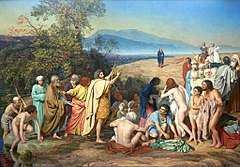Matthew 3:13
Matthew 3:13 is the thirteenth verse of the third chapter of the Gospel of Matthew in the New Testament. The verse introduces the section describing the baptism of Jesus by John the Baptist.
| Matthew 3:13 | |
|---|---|
← 3:12 3:14 → | |
 Alexander Ivanov's The Appearance of Christ to the People showing Jesus arriving at the Jordan | |
| Book | Gospel of Matthew |
| Christian Bible part | New Testament |
Content
In the King James Version of the Bible the text reads:
- Then cometh Jesus from Galilee to
- Jordan unto John, to be baptized of him.
The World English Bible translates the passage as:
- Then Jesus came from Galilee to the
- Jordan to John, to be baptized by him.
For a collection of other versions see BibleHub Matthew 3:13.
Analysis
Jesus re-enters the narrative for the first time since Matthew 2:23. In that verse he moves to Nazareth in Galilee. In this verse he returns from that region to Judea. From Nazareth to the Al-Maghtas, the traditional site of the baptism of Jesus and the ministry of John the Baptist, is about 30 miles using modern Highway 71.[1]
Howard Clarke notes that according to tradition Jesus was baptized in the Jordan River five miles south of the Allenby Bridge, today the site of a Greek Orthodox monastery dedicated to John the Baptist. The area is currently in a military zone and is closed to visitors.[2] This verse differs considerably from the description of the same event in Luke 3:21. In Luke's account, Jesus is one of the crowd that has come to see John and it does not specify who baptized Jesus. Nor does the version at Mark 1:9 provide many details. Matthew's gospel is much more specific, describing Jesus seeking out John to be baptized.
German theologian Heinrich Meyer lists a number of reasons which, in his opinion, fail adequately to explain why Jesus came to be baptized by John:
- "not in the personal feeling of sinfulness (B. Bauer, Strauss, Pécaut), or as the bearer of the guilt of others (Riggenbach, Krafft); not even because He, through His connection of responsibility with the unclean people, was unclean according to the Levitical law (Lange),[3] or because He believed that He was obliged to regard the collective guilt of the nation as His guilt (Schenkel); just as little in order to separate Himself inwardly from the sins of the nation (Baumgarten), or make it certain that His Greek: σὰρξ ἀσθενείας, sarx astheneias, should not be opposed to the life of the Spirit (Hofrnann, Weissag. und Erfüll. II. p. 82), or because the meaning of the baptism is: the declaration that He is subjected to death for the human race (Ebrard); not even to bring in here the divine decision as to His Messiahship (Paulus), or to lay the foundation for the faith of others in Him, so far as baptism is a symbol of the regeneration of those who confess Him (Ammon, L. J. I. p. 268), or in order to honour the baptism of John by His example (Calvin, Kuinoel, Keim), or to bind Himself to the observance of the law (Hofmann, Krabbe, Osiander); or because He had to conduct Himself, before the descent of the Spirit, merely as an Israelite in general. The opinion also of Schleiermacher, that the baptism of Jesus was the symbolical beginning of His announcement of Himself, and, at the same time, a recognition of John’s mission, is foreign to the text".
Instead, Meyer suggests that "the true meaning appears from Matthew 3:15, namely, because Jesus was consciously certain that He must, agreeably to God’s will, subject Himself to the baptism of His forerunner, in order (Matthew 3:16-17) to receive the Messianic consecration; that is, the divine declaration that He was the Messiah".[4]
According to David Hill, the relationship between Jesus and John the Baptist was one of the most important issues of first century Christianity and Matthew is very specific in these matters.[5]
References
- Google Maps, accessed 29 November 2016. Note that France, R.T., The Gospel of Matthew refers to a journey of about 70 miles (110 km). Wm. B. Eerdmans Publishing, 2007 pg. 119
- Clarke, Howard W. The Gospel of Matthew and its Readers: A Historical Introduction to the First Gospel. Bloomington: Indiana University Press, 2003.
- Probably referring to Johann Peter Lange
- Meyer's NT Commentary on Matthew 3, accessed 29 November 2016
- Hill, David. The Gospel of Matthew. Grand Rapids: Eerdmans, 1981
| Preceded by Matthew 3:12 |
Gospel of Matthew Chapter 3 |
Succeeded by Matthew 3:14 |